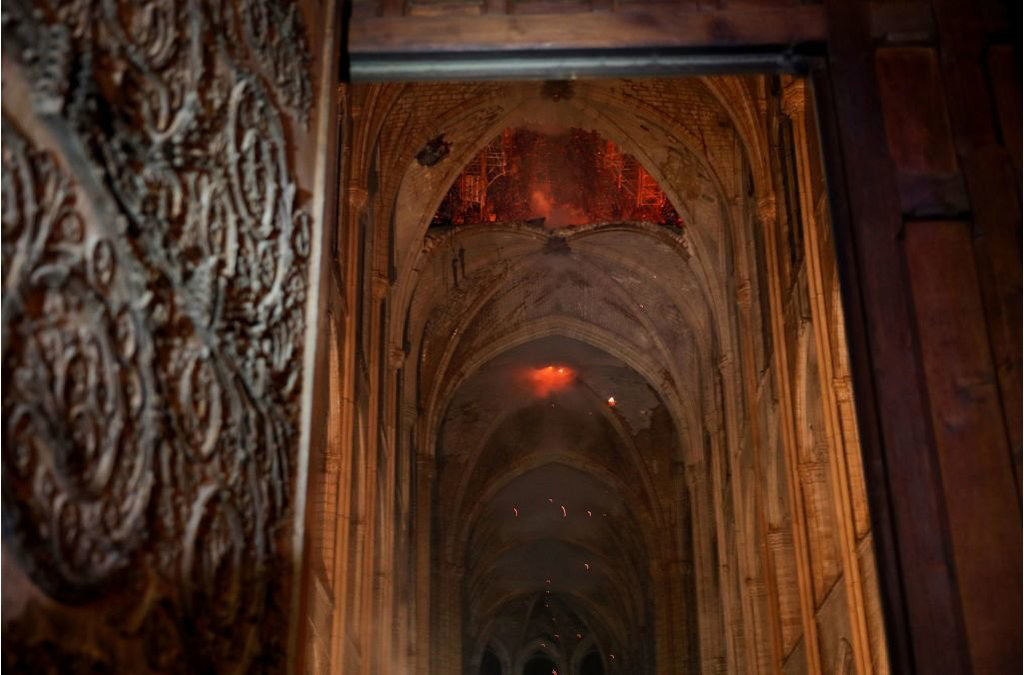重修巴黎圣母院难度有多大?同样木料在欧洲已近绝迹
|
上周一,巴黎圣母院的塔楼燃起了熊熊大火。大约400名消防员赶到现场,努力挽救这座在欧洲历史和建筑史上具有重大象征意义的建筑。 这场大火持续了12个小时,建于公元13世纪的塔楼被烧毁。目前起火的原因仍未查明。巴黎警方称,大火在上周二早上已经熄灭,并指出巴黎圣母院的石质结构仍然完好。 正如法国总统埃马纽埃尔·马克龙在上周一晚上所说的那样,尽管“已经避免了最坏的情况”,不过从有关报道来看,这场大火带来的损失仍然是极为沉重的。从媒体报道来看,巴黎圣母院的尖顶及支撑它的框架都被烧毁。马克龙虽然表示要修复巴黎圣母院,但要重建这座拥有856年历史的宏伟教堂,面临的困难还是不小的。现在,巴黎圣母院原有的橡木框架烧毁殆尽,同时欧洲的古老森林也在日益萎缩,已经很难找到修建巴黎圣母院时使用的同样的木料了。 |
As flames erupted in the attic of Paris’s Notre Dame Cathedral on last Monday, some 400 firefighters rushed to save one of Europe’s great historical and architectural symbols. The blaze, the cause of which remains unknown, raged for 12 hours, toppling Notre Dame’s 13th Century center spire in the process. The Paris Police Force deemed it extinguished on last Tuesday morning, noting that the stone structure of the cathedral had been saved. Even though “the worst has been avoided,” as President Emmanuel Macron said last Monday night, early reports of the damage are devastating. They indicate that the cathedral’s roof and the frame that supports it are gone. That will pose a particular challenge to efforts to rebuild the 856-year-old church, which Macron has vowed to do. As the oak frame met its end, so too did remnants of Europe’s dwindling ancient forests. |

|
用于修建巴黎圣母院的木料最早是在1160年至1170年间砍伐的。在砍伐时,有些木料的树龄估计已经有三四百年之久。其中最古老的一截木料估计已经有1300岁的高龄。 环保组织 “帕特里莫基金会”( Fondation du Patrimoine)的副主席贝特朗·德·费多表示,要想找到与原始橡木结构大体差不多的木料,几乎是一个不可能完成的任务。他对美联社表示,修建巴黎圣母院所用的木料都来自于基本上未经人类活动破坏的原始森林。他认为,现在那些巨大的树木和原始森林一样,已经不复存在了。 巴黎圣母院的官网指出,早在12世纪,也就是巴黎圣母院刚刚修建的时候,人类活动已经成了影响法国森林覆盖率的重要因素。随着城市化和大规模开荒的进行,当时的法国已经很难找到适合巴黎圣母院使用的巨大树木了。 自那时以来,人类活动对原始森林的影响变得愈加明显。 根据去年5月发表的一项研究,欧洲仅有4%的林地是原始森林。在俄罗斯和北欧以外的欧洲,原始森林的面积不超过500平方公里。 该研究的第一作者、德国生物多样性综合研究中心的研究员弗朗西斯科·玛利亚·萨巴蒂尼博士表示,尽管法国大陆近三分之一的地区都被森林覆盖,但只有0.01%的森林没有被砍伐,其中有些树木的树龄可能在200到400岁之间。 他表示:“保存至今的原始森林的面积很小,也很脆弱,而且对于生物多样性来说十分珍贵。由于地理位置偏僻或历史原因,它们在密集的砍伐活动中幸存了下来,成了一个个‘珍珠’或‘孤岛’。” 根据美联社的翻译,德·费多似乎将一棵树的大小与原始森林的原始程度联系了起来。对此,萨巴蒂尼表示,这种说法未必是正确的,对于那些树龄达几百年的古树,并不一定最大的就是最古老的。光用眼睛看,是很难分辨出一棵100岁的树和一棵400岁的树谁更古老的。 他表示:“树的大小和年龄几乎没有什么关联。” 德·费多的帕特里莫基金会并未及时回复《财富》杂志的评论请求。 目前,对欧洲原始森林的砍伐不禁没有停止,在一些地区反而还有愈演愈烈之势。大片的原始森林基本只存在于北欧和东欧的偏远地区。近年来,随着市场对木材的需求上升,木材价格也是水涨船高,这也鼓励了一些偏远地区的砍伐活动,其中有的甚至是非法砍伐。 最终,无论是从原始森林,还是从别的地方,要想找到早于法国中世纪的树木作为木料,基本上是不可能的。 萨巴蒂尼表示:“从最后的原始森林中选用木料,意味着也会失去这些古树。而且原始森林的损失,也并不能弥补失去巴黎圣母院的损失。它只是两场悲剧的叠加。” 德·费多也得出了同样的结论。他表示,巴黎圣母院必须依赖新技术进行重建。(财富中文网) 译者:朴成奎 |
The wood for the soaring cathedral was first felled around 1160 to 1170, with some of it coming from trees thought to be 300 to 400 years old at the time they were chopped. That puts the oldest timber in the cathedral at nearly 1,300 years old. Replacing those beams with comparable oak is simply not an option, said Bertrand de Feydeau, vice president of the preservation group Fondation du Patrimoine. Trees that supplied the roof’s frame came from primary forests—forests that are largely untouched by human activity, he said, according to the AP. He surmised that the huge trees associated with primary forests are gone too. Notre Dame’s official website notes that even in the 12th century, when the cathedral was being built, human activity was already a concern for French forests, with urbanization and land clearing making it difficult to source wood large enough for the design of the cathedral. Since then, the impact of human activity on primary forests has only become more pronounced. Only 4% of Europe’s remaining woodland is primary forest, according to a study published last May, with none larger than 500 square kilometers outside of Russia or Northern Europe. While forest covers nearly a third of mainland France, just 0.01% of it is untouched, containing trees around 200 to 400 years old, said Dr. Francesco Maria Sabatini, a lead author on the study and a researcher at the German Centre for Integrative Biodiversity Research. “Primary forests are small, fragile and precious for biodiversity,” he said. “They represent ‘pearls’ or ‘islands’ that survived intensive logging thanks to their remoteness or historical accidents.” Based on the AP’s translation, de Feydeau associated a tree’s size with its primary forest origin. That’s not necessarily accurate, Sabatini said; the oldest trees aren’t always the largest ones when we’re measuring a tree’s age in centuries. It’s borderline impossible to visually tell the difference between a living tree 100 years old and one that’s 400 years old, he said. “There is very little correlation between size and age,” he said. De Feydeau’s Fondation du Patrimoine did not return Fortune‘s request for comment. Nonetheless, logging of Europe’s ancient forests has not only continued but increased in some areas. Large forests of that kind only exist in remote regions in northern and Eastern Europe, where rising demand for timber has pushed up prices and encouraged logging in more distant areas, with some of it being done illegally. Ultimately, there is simply no way to replace wood that predates the founding of even medieval France—from ancient forests or otherwise. “Extracting timber from the last primary remnants means losing also these, and this loss won’t cover up the tragedy of losing Notre Dame,” said Sabatini. “It will simply add up.” De Feydeau seemed to come to this conclusion too: Notre Dame, he said, will have to rely on new technologies to rebuild. |













